Text
#Paleostream 26/07/2025
here's this week's #Paleostream flocking drawings!!!
this week we drew Palaeocampa, Nektognathus, Wudingloong, and Mirasaura




51 notes
·
View notes
Text

Oh BOY! Story time! All the way back in 2016, on our way back from Munich for a EAVP meeting Sven Sachs got a mail by Georg Göltz, attached were some first images of an incredible specimen. That evening we went over the material again and again...

I remember saying, "well, that looks like a large owl feather" and oh boy... Some time after Sven got Johan Lindgren and Dean Lomax on board who likewise recognized the importance of the fossil and made it happen that all the necessary tests were done to ensure that...

We would get as much information out of the specimen as possible! Now, quite a few years later we can finally show what has been brewing behind the academic curtains for a while.

Temnodontosaurus is a ichthyosaur taxon that is nearly as old of Paleontology itself, and yet, after more than 200 years of research history new details still reveal themselves. This flipper that Georg Göltz found not only showed the flipper outline that was unexpected...

But also revealed completely novel structures that have never been found in a living or extinct animal. Already, kind of, known where the parallel skin grooves that are very visible, even under normal light, but more important are the tiny, light structures on the back of the fin...

These are not bony but cartilaginous in nature and get the new name, chondroderms. These tiny spikes, embedded in the skin, supported a serrated trailing edge that stretched over nearly the full length of the flipper. As closer inspection revealed that these weren't just...

...impressions but that large portions of the skin structure were preserved. Which this wealth of data the researchers were able to do something pretty cool, they could build a digital model of a Temnodontosaurus flipper and test it's properties.

While not that efficient in improving the hydrodynamic properties these structures seem to reduce noise, similar to owl feathers! A puzzle piece that was so far completely absent from any considerations about the livestyle of these early Jurassic predators!
However this fits well to what we already knew. Large eyes, long but robust jaws and stomach content that consists of other fast prey like belemnites and other ichthyosaurs speak for a ambush predator, in this case a silent one.


I became part of this project first as a interested observer but only a few month before it went into review Johan asked me to make some artwork of the press release. As I had a rather tricky perspective in mind I actually build for this a model of Temnodontosaurus.
Eventually a took a shot of the model in a way that satisfied me and I went to finish it digitally. We decided to show it swimming into a swarm of belemnites. The specimen has a small flipper injury to show of better that structure of the fin.

There is much more to say about this fossil but thankfully the paper, published in Nature, is OPEN ACCESS! have a look!
2K notes
·
View notes
Text
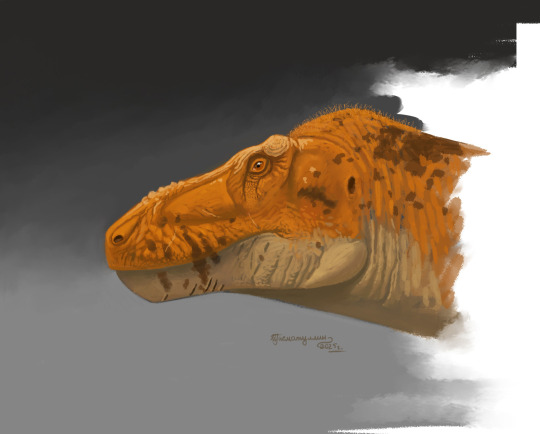
An experimental portrait of Tarbosaurus bataar, painted last night. Here I tried brushes imitating oil paint and charcoal. :)
Tarbosaurus is a close relative of Tyrannosaurus, known mainly from many specimens of different ages from the Maastrichtian of Mongolia. It was first described from a partial skull and vertebrae of an adult by paleontologist Evgeny Maleev in 1955 as a species of Tyrannosaurus. Maleev then described other specimens as a new genus Tarbosaurus and a species of Gorgosaurus. Later, they were all classified in the same genus. Tarbosaurus was slightly smaller than Tyrannosaurus, but had a fairly large skull (135 cm in the holotype). It differs from its American relative in its even smaller arms, the number of teeth, and a number of features of the skull structure (for example, an immobile joint in the middle of the lower jaw). Based on the isotopic composition of its tooth enamel, Tarbosaurus fed on sauropods and hadrosaurs; traces of its teeth were also found on the gastralia of Deinocheirus.
Adobe Photoshop, 2025.
19 notes
·
View notes
Text

Reconstruction of the noasaurid Kiyacursor longipes from the Early Cretaceous of the Kemerovo Region (Russia). The partial skeleton of this dinosaur was found in 2023 at the Shestakovo 1 locality. It consists of the left scapulocoracoid, humeri, cervical and trunk vertebrae and ribs, and most of the articulated hind limbs. In addition, a partial cervical vertebra was attributed to Kiyacursor. The holotype could have reached 2.5 meters in length, but histology of the leg bones showed that it was not fully grown. The hind legs are long, with a very narrow metatarsus, which indicates the ability to run quickly. Unlike other cursorial theropods, Kiyacursor has a highly developed third (middle) metatarsal and reduced second and fourth. The humeri are very small. Due to the lack of a skull, it is difficult to judge the diet of the animal. Kiyacursor is part of a fauna characterized by the presence of relics from the Jurassic period.
Paint Tool Sai 2.0, 2025.
#kiyacursor#limusaurus#elaphrosaurus#noasauridae#theropod dinosaur#dinosaurs of russia#early cretaceous#paleoart
7 notes
·
View notes
Text
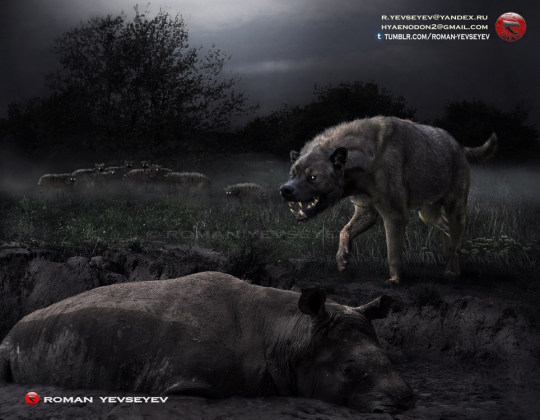
Late Miocene of Asia. The hornless rhinoceros, Chilotherium, is stuck in the thick mud. Ancient hyenas Ictyterium scurried around the mud pit, awaiting his death. But they retreated in fear when appeared the real owner of the these graves - Dinocrocuta Поздний миоцен Азии. В загустевшей грязи крепко увяз безрогий носорог хилотерий (Chilotherium). Ожидая его смерти, около грязевой ямы крутились древние гиены иктитерии (Ictitherium). Но они отступили перед настоящим хозяином здешних могильников - динокрокутой (Dinocrocuta).
16 notes
·
View notes
Text
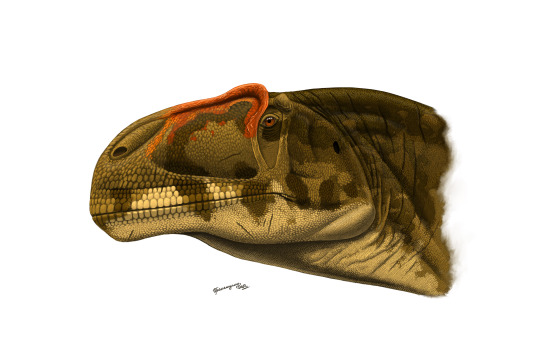
Portrait of tetanuran Asfaltovenator vialidadi from the Lower Jurassic of Argentina. The holotype of this theropod was discovered in 2002 in the sediments of the Cañadón Asfalto Formation and extracted in 2007. The specimen is represented by a skull with a lower jaw and a partial postcranium. The Asfaltovenator is characterized by a mixture of features of early theropods and more progressive tetanurans. It was originally classified as a basal allosauroid, but in 2024, Andrea Cau placed it next to Sciurumimus in the megalosauroids. At the same time, according to the results of other analyses, the closest relative of the Asfaltovenator was the later Allosaurus. Asfaltovenator was a large animal about 8-9 meters long. It co-existed with a number of other theropods, including Piatnitzkysaurus and ceratosaur Eoabelisaurus.
Adobe Photoshop, 2025.
#asfaltovenator#allosaurus#allosauridae#tetanuran#theropod dinosaur#lower jurassic#jurassic period#dinosaurs of argentina#paleoart#portrait
20 notes
·
View notes
Text

A red sketch of a Tyrannosaurus rex, drawn on the day of the publication of the work on exoparia, a soft-tissue structure connecting the jugal bones to the lower jaw. (The article is just in case: onlinelibrary.wiley.com/doi/full/1 …) Dinosaurs from different groups have a characteristic curve of the cheekbone, as well as rugosities, indicating the attachment of the exoparia. This is also confirmed by the histology of the jugal and surangular bones in hadrosaurids, ceratopsids, and tyrannosaurids, where collagen fibers were found in the outer cortex. There are similar correlations for soft tissues in modern chickens. The exoparia could stabilize the jaw during feeding. Here I tried to emphasize it a little with shadows. Usually, an osteoderm is drawn on the pointed protrusions of the cheekbones of tyrannosaurids, but this does not agree with the new data (the exoparia was attached, among other things, to the location of the osteoderm). However, it is likely that decorative scales without a bone base were located on the outside of this place.
Paint, 2025.
#tyrannosaurus rex#tyrannosaurus#tyrannosauridae#theropod dinosaur#dinosaur exoparia#dinosaur anatomy#paleoart#red sketch#made in paint
34 notes
·
View notes
Text

Portrait of the giant gorgonopsian Inostrancevia alexandri from the late Permian of the Arkhangelsk region (Russia). Its skeletons and individual skulls were found by the Russian paleontologist V. P. Amalitsky at paleontological excavations at the location of Sokolki. The skull is high and laterally compressed, up to 50 cm long. The front teeth are well developed, especially the saber-shaped upper canines with saw-toothed edges (crown length up to 15 cm) stand out. A characteristic feature of Inostrancevia is the presence of small occluded teeth only on the upper jaw. Despite its huge size (body length 3-4 meters), the skeleton is quite light. The paws have large claws. In addition to the type species depicted here, the larger I. latifrons and the extremely fragmentary (only the cranial region is known) I. uralensis, as well as the recently described I. africana from South Africa and Mozambique, which turned out to be one of the last gorgonopsians, were also identified. Inostrancevia hunted mainly pareiasaurs and dicynodonts.
Paint, 2025.
#inostrancevia alexandri#inostrancevia#lycaenops#gorgonops#gorgonopsid#therapsids of russia#therapsid#non mammalian synapsids#late permian#fossils of russia#paleoart#made in paint
25 notes
·
View notes
Text

Speculative portrait sketches of the megaraptorid Maip macrothorax from the Maastrichtian of Argentina. This theropod is described based on a partial postcranial skeleton, including, among other things, an epistropheus, several trunk vertebrae, and ribs. Despite its fragmentary state, Maip is interesting because it is the largest known megaraptorid: its length is estimated at 9-10 meters. The generic name of the dinosaur comes from an evil creature from the Aonikenk mythology that killed with a cold wind, and the specific name refers to the large size of the body.
Since the skull of Maip has not been found, its head is reconstructed based on the known material of other megaraptorids. But it is unlikely that representatives of this family had absolutely identical skulls. Therefore, I decided to depict a taller head on the right, convergent with carcharodontosaurids.
Paint, 2025.
#maip#maip macrothorax#megaraptor#australovenator#megaraptoridae#coelurosaur#theropod dinosaur#late cretaceous#paleoart#made in paint
13 notes
·
View notes
Text
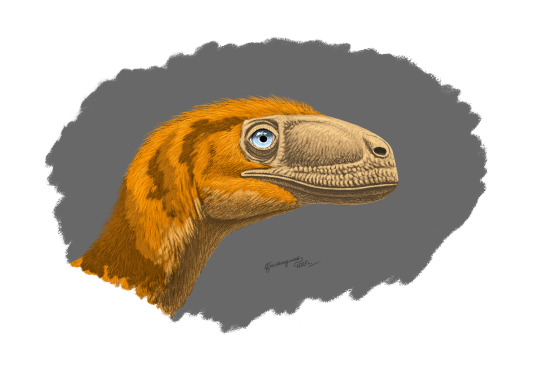
Portrait of the coelurosaur Huadanosaurus sinensis from the Lower Cretaceous Yixian Formation (China). It is described based on a nearly complete skeleton of a juvenile with a skull about 10 cm long and a total length of about a meter. This specimen was previously attributed to Sinosauropteryx. Huadanosaurus has many tyrannosauroid features: a high skull with fused nasal bones and well-defined muscle areas on the lower jaw, indicating a strong bite. The authors of the description explained this set of features by convergence. However, some other paleontologists, in particular Christoph Hendrickx, have suggested that Huadanosaurus may be a juvenile Yutyrannus or a related form. The holotype has preserved tail feathers with melanosomes, the shape of which corresponds to the red color.
Adobe Photoshop, 2025.
#huadanosaurus#sinosauropteryx#yutyrannus#coelurosaur#theropod dinosaurs#dinosaurs of china#feathered dinosaurs#yixian formation#early cretaceous#paleoart
26 notes
·
View notes
Text

Recently tried drawing with new gel pens. :)
A portrait sketch of a large cynodont, Diademodon tetragonus, from the Middle Triassic of Africa and Argentina. It was originally described from the Burgersdorp Formation in the Karoo Basin (South Africa). Diademodon is considered herbivorous or omnivorous, its dentition combines well-defined sharp canines and cheek teeth with precise occlusion, designed for eating plants. The very wide postorbital part of the skull contained highly developed temporal muscles. A study of the histology of the bones showed that Diademodon, unlike the contemporary predatory Cynognathus, had a cyclical growth strategy dependent on seasonal changes. Data on stable isotopes in the teeth confirmed this. Diademodon was a rather slow animal about two meters long.
Black and white gel pens (and a little white pencil), 2025.
#diademodon#cynognathus#thrinaxodon#cynodont#therapsids#non mammalian synapsids#triassic#paleoart#craft paper
7 notes
·
View notes
Text
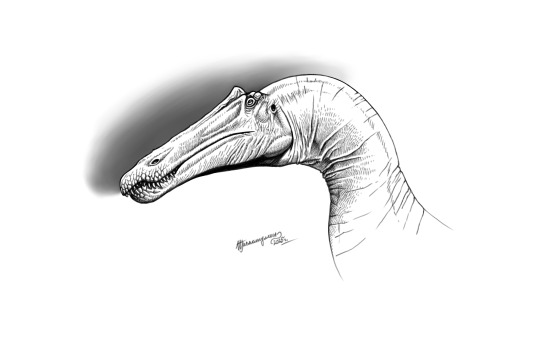
Portrait sketch of the spinosaurid Suchomimus tenerensis from the Early Cretaceous of Niger. This is one of the spinosaurids known from relatively complete remains, including parts of the skull. The length of the Suchomimus is estimated at 9.5-11 meters, but the ontogenetic stage of the holotype is unknown, so the maximum size of this dinosaur is unclear. The skull is long and very narrow, with a characteristic notch in the upper jaw. There was a low ridge along the back. Judging by the structure of the leg bones, Suchomimus preferred to hunt in shallow water. Some paleontologists consider it to be one of the species of related Baryonyx, synonymy with contemporary, but much more fragmentary, Cristatusaurus lapparenti has also been suggested. Suchomimus co-existed with unusual dinosaurs such as Ouranosaurus and Nigersaurus, as well as various crocodylomorphs.
Paint Tool Sai 2.0, 2025.
#suchomimus#cristatusaurus#baryonyx#baryonychinae#spinosaurus#spinosauridae#theropod dinosaurs#cretaceous period#paleoart
15 notes
·
View notes
Text
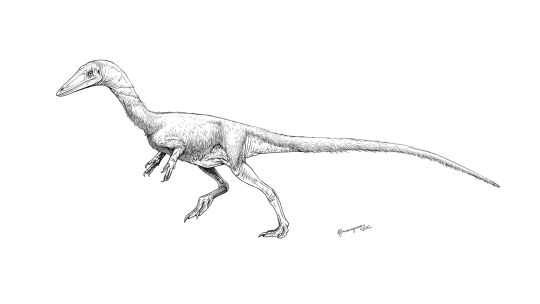
Detailed sketch of the famous Late Triassic theropod Coelophysis bauri. Many remains of this dinosaur, including complete skeletons, have been found on a Ghost Ranch in New Mexico. Coelophysis was a three-meter-tall predator with a light build, a small body and a long neck and tail. There were numerous small knife-shaped teeth in the long and thin jaws. Bones of small reptiles were found inside some of the skeletons, which were believed to be Coelophysis chicks. Because of this, it gained fame as a cannibal dinosaur. Later it turned out that the victims were terrestrial crocodylomorphs like Hesperosuchus. Another specimen still has evidence of cannibalism - regurgitated tooth and bones of a baby Coelophysis next to the jaws. For a long time, it was believed that gracile and robust individuals existed, possibly being males and females, but later research showed that this was the result of varying growth and intraspecific variability.
Krita, 2025.
#coelophysis#liliensternus#lucianovenator#coelophysidae#dilophosaurus#theropod dinosaurs#chinle formation#late triassic fauna#paleoart
51 notes
·
View notes
Text
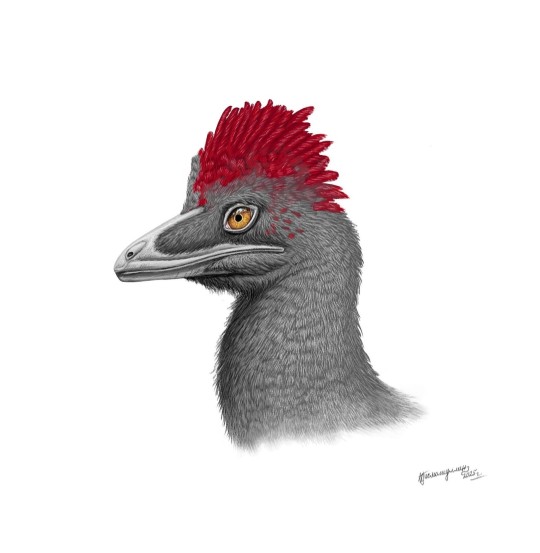
Color portrait of Anchiornis huxleyi, a paravian from the Upper Jurassic of China. Hundreds of specimens of this dinosaur have been found in the rocks of the Tiaojishan Formation. Some of these skeletons have preserved traces of soft tissues, including abundant plumage. Anchiornis was feathered from head to toes, it had long feathers on his wings and legs. However, it moved poorly through the air - the flight feathers were thin and symmetrical, fluffy feathers on the neck and body worsened aerodynamics. There was a crest of long feathers on his head. In some specimens, scales were found on the legs, coexisting with feathers. Examination of the preserved melanosomes revealed the presence of gray and black colors on the body and limbs. The flight feathers and wing coverts were white with black tips, and the crest was reddish. Judging by the faint curve of the claws of the legs, Anchiornis was a running animal. Some individuals still have pellets filled with lizard bones and fish scales.
Paint 3D, 2024.
#anchiornis#aurornis#troodontidae#paraves#feathered dinosaurs#dinosaurs of china#late jurassic#paleoart
74 notes
·
View notes
Text

And here it is, our second Cambrian formation piece! This time we visited the even older Surius Passet from Greenland, our first real deep sea deposit.
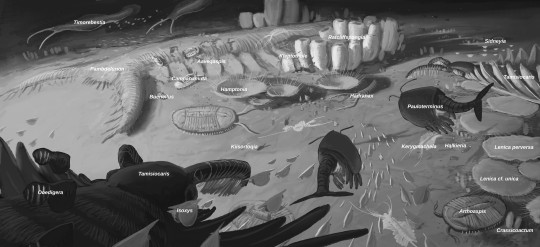
As most animals down here have no or only small eyes the color palette was rather limited and most practical. A bigger challenge was however the largest animal here, Pambdelurion, an over 50 cm long panathropod. Making room for it proofed to be exceptionally tricky.

Only a day before the stream discord member Levi finally had a silly yet genius idea: we would use the opening battle from Revenge of the Sith as our our basic inspiration. It's not the first time I turned Cambrian critters into spaceships so that fit incredibly well!
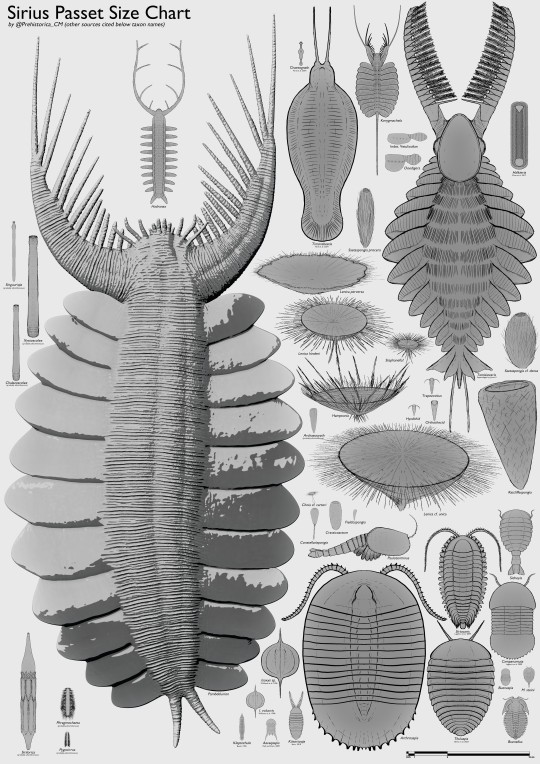
In combination with this fantastic size chart by Prehistorica ( https://x.com/Prehistorica_CM ) I went to work and I think I'm quite happy with the result.
791 notes
·
View notes
Text
One day last year, I decided to draw dinosaurs from memory and at the same time experiment with brushes in Photoshop. I wanted to see how well I remember the distinctive features of animals. The result was these four sketches.
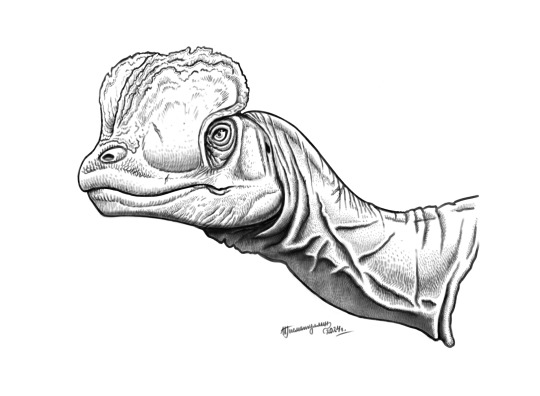
Dilophosaurus wetherilli portrait. It was a large and relatively primitive predatory dinosaur from the Early Jurassic of the USA. It is well known for the two thin crests on its head that served for demonstrations. It was probably a versatile hunter, capable of picking up small prey like fish with a hook on its upper jaw, as well as killing other dinosaurs with its blade-like serrated teeth.

Allosaurus fragilis portrait. I tried other brush here. I liked how the wrinkles and creases of the skin appear when using it. Note the soft tissues of mouth corner, exoparia paper was not published yet then.
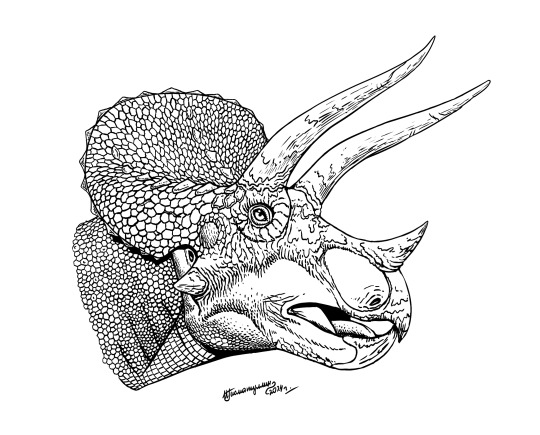
Triceratops horridus portrait. It was a bit more complicated than the theropods because of the frill. In addition, it took much more time to draw large scales. But in the end it turned out quite well. Triceratops was the most widespread herbivore in North America at the end of the Cretaceous and one of the largest ceratopsians. It was part of the classic dinosaur fauna, among which were such "stars" as Tyrannosaurus and Edmontosaurus. Triceratops is known for its large number of skulls and skeletons of varying preservation. It famous three horns and frill were used to protect it from predators and in battles with its kindred.
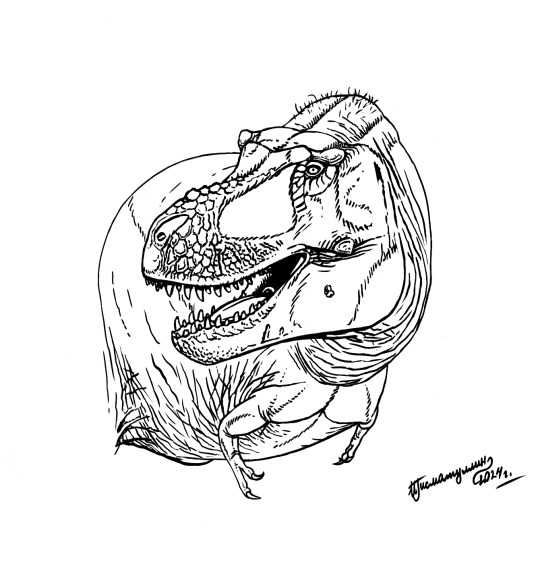
And of course, a dinosaur that needs no introduction. It shows a reconstruction of extraoral tissues like those of alligator (many paleontologists now consider it less plausible than the now-common version with "lips"). Adobe Photoshop, 2024.
#dilophosaurus#allosaurus fragilis#allosaurus#triceratops horridus#triceratops#tyrannosaurus rex#tyrannosaurus#dilophosauridae#allosauroidea#ceratopsidae#ceratopsian#tyrannosauridae#theropod dinosaur#theropod lips#sketches#paleoart
21 notes
·
View notes
Text

Last year's portrait sketch of Moschops capensis, a tapinocephalid dinocephalian from the "Middle" Permian of South Africa. It is the most famous representative of his group. Reaching almost three meters in length, it possessed a massive body typical of tapinocephalids, strong limbs and a short tail. It is assumed that such a physique helped to keep warm. The skull is expanded at the back and has a very thick frontal-parietal region. Perhaps the Moschops were bumping heads or butting heads, trying to sort things out. It is also possible that the well blood supplied integument of the thickened head areas helped to shed excess heat. Teeth with ridges on the lingual (inner) side helped to crush plant food. Several similar genera of dinocephalians have been described, which are now considered synonymous with Moschops.
Paint Tool Sai 2.0, 2024.
#moschops capensis#moschops#tapinocephalus#tapinocephalidae#dinocephalia#therapsids#non-mammalian synapsids#permian period#portrait#sketch#paleoart
21 notes
·
View notes